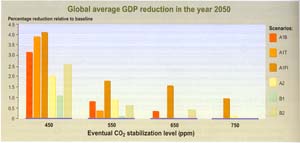 |
Figure 7-4: Indicative relationship
in the year 2050 between the relative GDP reduction caused by mitigation
activities, the SRES scenarios, and the stabilization level. The reduction
in GDP tends to increase with the stringency of the stabilization level,
but the costs are very sensitive to the choice of the baseline scenario.
These projected mitigation costs do not take into account potential benefits
of avoided climate change.
The
decline in energy R&D expenditure is inconsistent with the goal of
accelerating the development and deployment of advanced energy technologies.
Energy-related R&D expenditure by Annex II governments increased dramatically
after the 1970 oil price increases, but as a group it has decreased steadily
in real terms since the early 1980s. In some countries the decrease has
been as great as 75%. The support for energy conservation and renewable
energy R&D has increased. However, other important energy technologies
relevant to climate change, such as, for example, commercial biomass and
carbon capture and storage, remain minor constituents of the energy R&D
portfolio.
Social
learning and innovation and changes in institutional structure could contribute
to climate change mitigation. Changes in collective rules and
individual behaviors may have significant effects on greenhouse gas emissions,
but
take place within a complex institutional, regulatory, and legal setting.
Several studies suggest that current incentive
systems can encourage resource-intensive production and consumption patterns
that increase greenhouse gas emissions in all sectors (e.g., transport
and housing). In the shorter term, there are opportunities to influence
through social innovations individual and organizational behaviors. In
the longer term, such innovations in combination with technological change
may further enhance socio-economic potential, particularly if preferences
and cultural norms shift towards lower emitting and sustainable behaviors.
These innovations frequently meet with resistance, which may be addressed
by encouraging greater public participation in the decision-making process.
This can help contribute to new approaches to sustainability and equity.